A to Z Literacy Movement: Multicultural Book Clubs across Grade Levels
Introduction to Our Community: Ann Yanchura
The A to Z Literacy Movement is a grass roots educational mission started by Mal Keenan, a teacher and literacy coach, to provide literacy support in terms of books for children and professional development for the adults who work with them in our local communities northwest of Chicago and to schools in Zambia. As part of our local outreach, we wrote a grant to partner with the local school district and create middle school book clubs whose members would share quality multicultural literature with first graders in a nearby Title One school.
Our stateside adult members are all teachers and literacy coaches who met to learn more about integrating multicultural literature book discussions into our curriculum. In addition to our “stateside” work and learning, we also partnered with Chisiko Community School in Chongwe, Zambia, to offer professional development opportunities to teachers and to share our books with their students.
The project in America consisted of one middle school book club at each of three middle schools who met over the course of the 2012-13 school year to read and discuss multicultural picture books and plan lessons for presenting these books to first graders. The picture books chosen include The Gift of the Sun: A Tale from Africa (Stewart & Daly, 2007), Sitti’s Secrets (Nye, 1997), and I Love Saturdays y domingos (Ada, 2004). We visited three different first grade classes in the fall, winter and spring to share the books, our love of reading, and the messages of empowerment, community, and learning that are found in high quality multicultural literature.
The following vignettes provide insight into our Book Clubs experiences and learning. It’s impossible to fully describe the exciting impact on our participants. We built bridges and community among our teachers and middle school students and across town to the first graders who came to love and respect their middle school friends. Our teachers and students grew in our understanding of just a few of the varied cultures that make up our schools as we read, thought deeply, and discussed them at length. As these teachers and literacy coaches shared their experiences with colleagues, a new understanding of the vital importance of making high quality multicultural literature a foundation of our instruction is growing and spreading across our school district.
Our professional development work is ongoing with our partner school in Africa through future Skype, email and face to face meetings. We are planning to seek funds to continue and grow this project in our school district based on the experiences of participating students and teachers and the interest of others in our community who would like to become a part of this work.
∞ Never Underestimate a First Grader: Mal Keenan
There is true power in picture books. Picture books offer rich language, incredible stories, and illustrations that add to the experience of any reader. When traveling to schools in Zambia with the A to Z Literacy Movement to help teachers and students, I always find the best lessons to model start with a picture book. As a former elementary school teacher, I’m always surprised at how few picture books are used in middle school classrooms today. Participating in the World of Words experience was enlightening for me as well as for the seventh-grade students.
Visiting Mrs. Hall’s first grade classroom on three different days, with three different multicultural stories was more than just a project; it was a life lesson for many of the students and adults involved. With each story, the kids became more aware of the multicultural lesson that was tied to each of the books and how much the first grade students had to offer. They took responsibility to ensure the reading and activities were successful and wanted to provide new information to their little first grade pals.
At the end of the project, the seventh-grade readers reflected on their experiences and what they had learned. After a group discussion, I asked the kids to complete an exit slip on their journey. So many of the exit slips made smile as I read through them: “Little kids are smarter than you think”, “I learned that 1st graders have lots of good ideas just like 7th graders, and “Reading educated us on new things and makes us think differently.” One student wrote “1st grade students are really good at noticing things”. The older students recognized the higher level of thinking that the younger students were doing and rose to the occasion. Additionally, the older readers reflected on their new multicultural knowledge and felt empowered to share newly learned information with others in their lives. This project stretched me as a teacher/literacy coach and I was happy to celebrate more multicultural literature in my district.
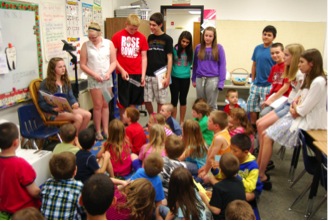 To take the success of this project one step further, the picture books we used in this project were then shared with a small school, Chishiko Community School, in Zambia, Africa. Work that was completed by students in Crystal Lake, IL was sent as examples of what could be done with students at Chishiko using the picture books, tying the schools, oceans apart, together with memorable stories.
To take the success of this project one step further, the picture books we used in this project were then shared with a small school, Chishiko Community School, in Zambia, Africa. Work that was completed by students in Crystal Lake, IL was sent as examples of what could be done with students at Chishiko using the picture books, tying the schools, oceans apart, together with memorable stories.
∞ We Should Do This More Often!: Ann Yanchura
These words were spoken by several middle school students involved in multicultural book clubs that met for three series of sessions over a school year. They were referring to both their meetings with their middle school friends after school and to the three visits we made to a local elementary school to share the books we had read.
Our project was based on the creation of middle school book clubs where students would read and discuss multicultural literature. There was one club at each of the three middle schools in our suburban school district. The teachers who facilitated these clubs had chosen three titles which we rotated among the groups so that each club had read all three titles by the end of the school year. In addition to our own reading and learning, we visited first grade classes at a local elementary school where the middle school students read these books to little ones and facilitated discussions and extension activities.
Obviously, time was an issue in such a complex project. Our middle school students met after school and their busy schedules sometimes interfered with this time commitment. We planned three meetings for each book in order to read it ourselves and prepare for the first grade visits. Each of these meetings included snacks of one kind or another, along with lots of laughing and talking. We heard several times that some students wished we had more meetings so they could enjoy the snacks and hanging out with their friends.
“Wow! The time went fast!” This was a typical reaction when we began to round up our group for the bus ride back to the middle school. Not only did the sixth graders wish they could spend more time, they also felt that we should make more visits to the first graders. Explaining that we didn’t want them to miss any more core instruction time was no consolation.
Now the interesting thing to me is that I agreed with them one hundred percent. We did NOT have enough time. Time, as we all know, is the bane of a teacher’s existence. If we teacher facilitators had more time with the sixth grade book clubs, we could have accomplished even more exciting things. There was not enough time to build the cultural background knowledge to help these kids understand the implications of the culture in order to read each book closely and carefully…not enough time for the deep reflection and discussion examining the issues in the book…not enough time to relax and enjoy each other…not enough time to bask in the glory or reading a great book…not enough time to really integrate the study of multicultural literature and make it an embedded part of our curriculum. I think that this was my biggest regret. Isolated instances of multicultural experiences, while beautiful in themselves, do not add up to a culturally sensitive and responsive education. Give us more time! We’ll continue on our path towards learning together and accepting each other! We can do it!
∞ Lessons from Our World of Words Experience: Amy MacCrindle
You’re never too old to grow as an educator. Through this A to Z grant experience I learned how to work with students in a new way. I’ve learned:
• Adolescents can be teachers: I was impressed at how good of teachers adolescent students can be as teachers. Our students were able to think about best practices and how to best teach the 1st graders. One of my favorite moments was when the middle school students began to use “teaching lingo” such as background knowledge, higher order questions, and speaking/listening. What was even more powerful was that the students actually implemented those strategies with the first graders.
• Adolescents can learn from first graders: On the bus ride back from school our students were buzzing with comments such as “wasn’t _____ so cute?” or “Jimmy loved me!” Additionally, we heard phrases like “I can’t believe Susie said this, I never thought of this” or “Have you ever thought of this before?” It’s amazing how much we can grow as people when we allow ourselves the opportunity to be affected by others, no matter their age.
• Adolescents do care: I have chosen to be at the middle school level because I love students at this age. That love has grown through this experience because I saw that adolescents care. They want to help others in their community. They want to be a good example to their peers. They want to learn about the world around them.
While I know that the first graders, my adolescent students, and the teachers in Africa grew because of this experience, I did as well. These lessons will continue to influence me and help shape my thinking of adolescent learners.
∞ Lesson Plans, Anyone?: Kimberlee Militello
While there were many signs of growth throughout the school year we were engaged in this project, one of most striking observations was in the growth of our seventh graders’ recognition that they needed to be more organized with their planning for our time with the first graders. In our planning sessions for our first visit, the 7th graders mainly worried about reading the text fluently. They really gave little real thought to what they would actually do with the text besides stopping and discussing parts as they read. While this was a good first step, they realized all too late that reading and noticing alone would not fill the hour of time they were given to “teach” the first graders.
During the first session, the seventh graders ran out of material and were forced to ad-lib. This was huge awakening. This made them uncomfortable. This made them want to prepare differently in the future.
Their feelings about having to “just reread the story a bunch of times” were the central discussion point during our second session planning meetings. The seventh graders understood that they still needed to read the story fluently, but they also had a new respect for the lesson planning portion of our meetings. In our second session the students asked if they could make “a lesson plan” that they could follow once we were with the first graders. As teacher leaders we immediately agreed. The students sketched out their ideas through the use of our classroom Smart board.
Suddenly, our informal meeting where kids chatted care-free and read in pairs changed dramatically. The students were more focused on their “job” as teachers. They took their work more seriously and thus produced higher quality activities for the first graders to engage in. The seventh graders often debated the merits of different activities and the order they wanted to present information/activities. Through this their confidence and the quality of lessons improved greatly.
Lesson Plan for I Love Saturdays y domingos
1. Point out that the book tells an idea in English then also uses the same idea in Spanish-Text Structure or Text Organization
2. Read the book
a. Stop and tell the words (Mark the words in the text).
3. Memory Game (Create the game).
4. Venn Diagram with Saturdays and domingos (make yarn circles, copy pictures, “Saturday” and “domingo” headings)
5. Organize the pictures in chronological order
∞ Learning to Believe in Yourself: Jenna Brogan
When eighth-grade students were asked if they were interested in reading with first graders, mixed emotions filled the classroom. Many were smiling, some were fearful, and others were anxiously hoping to be a part of the experience. My students each wrote me a persuasive note of why I should choose them for the visits to the elementary school. As the classroom teacher, I carefully chose twelve students, who I felt would be energetic, enthusiastic, and empathetic to read with first grade students.
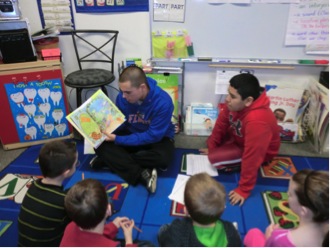 One student chosen stuck out among the rest. He wrote me a secret note with his concerns about this opportunity. He expressed his excitement about working with young boys and helping them learn to love reading like him; however, he was very reluctant due to his own learning “issues,” as he called them. This young fourteen-year-old receives special education services through his Individualized Education Plan (IEP). Throughout his elementary and early middle school years, he felt that he was always put down and told what he could not do. He rarely felt accepted or that anyone appreciated his unique personality and perspective. I spoke with David about his concerns and learned that he was most afraid of his speech. When David gets excited or nervous, he speaks very quickly! He knew that both of those feelings would continue to radiate within him as we entered the first grade classroom. Therefore, we came up with a plan, and he was pumped!
One student chosen stuck out among the rest. He wrote me a secret note with his concerns about this opportunity. He expressed his excitement about working with young boys and helping them learn to love reading like him; however, he was very reluctant due to his own learning “issues,” as he called them. This young fourteen-year-old receives special education services through his Individualized Education Plan (IEP). Throughout his elementary and early middle school years, he felt that he was always put down and told what he could not do. He rarely felt accepted or that anyone appreciated his unique personality and perspective. I spoke with David about his concerns and learned that he was most afraid of his speech. When David gets excited or nervous, he speaks very quickly! He knew that both of those feelings would continue to radiate within him as we entered the first grade classroom. Therefore, we came up with a plan, and he was pumped!
David and I had been practicing his reading and writing fluency in class. I made three copies of the picture book, The Gift of the Sun (Stewart & Daly, 2007), which we would be reading on our first visit. David gave one copy to his speech and language teacher, kept one for home, and put the final on the reading table. Our plan was to practice as often as possible so he felt confident reading with his first grade friends. David didn’t want to be a poor example to the new young readers, and he wasn’t! He walked into that first grade classroom with his head held high, a smile on his face, and a welcoming demeanor. Time and practice was exactly what he needed, but more importantly, he needed to believe in himself.
∞ Unusual Suspects: Gabriela Carbajal
The objective was clear: gather a group of sixth-grade students to read and explore multicultural picture books to then bring to a first grade classroom to read and transfer the understandings which we gained. The part which was not entirely clear was how I should select such group of students. As teachers, we all have our “star” students. Those who volunteer for projects, are high achievers, and are involved in many extracurricular activities. Those are the students I decided not to pick for this particular project. Maybe this was a bit of a selfish decision, but I wanted to see my quiet, struggling and sometimes off-task students in a different light. I am happy to say I succeeded.
There were two students in particular who surprised me the most: one was Armando, a boy whose English is his second language and has the reputation of being the class clown; a reputation he lives up to. The second was a very reserved girl, Victoria, who did not participate much in class and was quiet all around.
I watched in amazement as my rambunctious Armando became a leader, rather than someone whose purpose was to make his classmates laugh, sometimes even at his own expense. During our after-school meetings, he came up with deep thoughts and ideas to pass on to our first grade friends. I could tell it was hard for him to take on this new personality, which made it all the more special for me to witness. He was able to surpass his classmates’ expectations and show a layer of his personality which nobody was aware of. During our trips to visit and read to the first grade class at one of our local elementary schools, this student stood out as one who could relate to the first graders (quite possibly because of the fact that he still has a small piece of childhood in him). He was patient while guiding them to a better understanding of multicultural literature and how it might connect to their own lives.
Victoria, who never acted much like a leader in our sixth-grade classroom, blossomed in the first grade class as the leader of her partnership and an amazing young educator. She was able to come up with and ask questions which elicited deep thinking, and did so at the right times during the reading. An otherwise somewhat uncomfortable girl in public, she seemed to be very much so in her element during our meetings and interactions with our young friends.
I won’t lie; because I decided to choose the “unusual suspects” for our WOW project, there were a few bumps on the road. Not all of my choices rose to the occasion, but I was very glad and it was so worth it for those who did. Although this mission was for the students to learn something new and spread the message of tolerance and acceptance, they taught me to think outside the norm of school culture and take a chance on those students who are typically thought of as NOT the ones to choose.
References
Ada, A. F. (2004). I love Saturdays y domingos. New York: Aladdin.
Fox, D. L., & Short, K. G. (2003). Stories matter: The complexity of cultural authenticity in children’s literature. Urbana, IL: National Council of Teachers of English.
Keene, E. (2012). Talk about understanding: Rethinking Classroom Talk to Enhance Comprehension. Portsmouth, NH: Heinemann.
Mendoza, J., & Reese, D. (2001). Examining multicultural picture books for early childhood: Possibilities and pitfalls. Early Childhood Research & Practice, 3(2), 155-169.
Nye, N. S. (1997). Sitti’s secrets. New York: Aladdin.
Stewart, D., & Daly, J. (2007). The gift of the sun: A tale from South Africa. London: Frances Lincoln.
Jenna Brogan is an 8th grade language arts/social studies teacher at Lundahl Middle School in Crystal Lake, Illinois. She volunteers at middle school walk-a-thons that raise money for A to Z Literacy Projects.
Gabriela Carbajal is a 6th grade dual language teacher at Hannah Beardsley Middle School in Crystal Lake, Illinois. She volunteers her time with the A to Z Literacy project at a local housing complex.
Mal Keenan is a middle school literacy coach at Bernotas Middle School in Crystal Lake, Illinois. She is the director and founder of the A to Z Literacy Movement and participates in their local outreach as well as leads literacy mission trips to Zambia.
Amy MacCrindle is a middle school literacy coach at Lundahl Middle School in Crystal Lake, Illinois. She supports the A to Z Literacy Movement through sponsoring walk-a-thons and other fundraisers at Crystal Lake middle schools.
Kim Militello is a 7th grade language arts/social studies teacher at Bernotas Middle School in Crystal Lake, Illinois. She also does professional development training for teachers in Colorado and Illinois.
Ann Yanchura is a middle school literacy coach at Hannah Beardsley Middle School in Crystal Lake, Illinois. She supports A to Z Literacy by participating in their local outreach, fundraising, and the literacy mission work in Zambia.
WOW Stories, Volume IV, Issue 6 by Worlds of Words is licensed under a Creative Commons Attribution-NonCommercial-ShareAlike 4.0 International License.
Based on a work at .

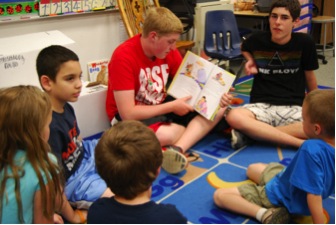
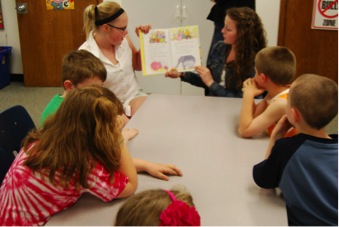
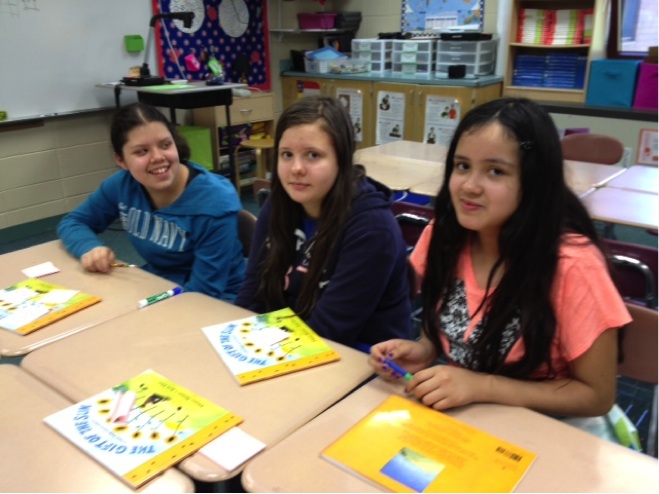
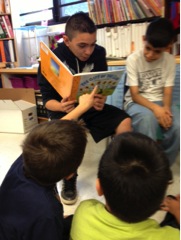
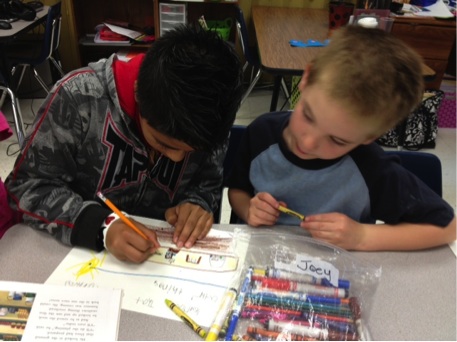
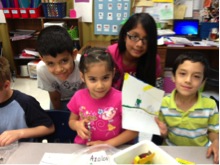
This is wonderful!
What a powerfully arming experience this was!
Bravo Maggie Burns- what a meaningful lesson these boys learned!